Integrate with a Content Management System to use the web feed utility
To use the web feed utility, we can integrate with any Content Management System that generates web feeds.
Follow this procedure to configure IBM Web Content Manager, packaged with WebSphere Portal,to generate web feeds. Creating feeds from IBM Web Content Manager is a two-step process:
- Create a template for the feeds by creating and configuring a Menu Component.
- Create sample data for feeds to output.
In this procedure, we use an example intranet site that is preinstalled with WebSphere Portal. The feed is managed by an Atom Feed Menu Component that creates an Atom feed for the existing site area. The feed is linked in the List presentation template. The Atom Feed Menu Component requires two 'CDATA' Text Components control rich text in the feed. To display your content on different pages, use a page URL mapping that refers to the page where the content is shown. Typically, design elements are stored in design library, but in this procedure you use the standard library 'Intranet 6.1.0' provided with the WebSphere Portal.
We can adapt this procedure to add feeds to other IBM Web Content Manager managed sites.
Procedure
- Add an Atom feed to your existing website.
- Use Mozilla Firefox, open...
This intranet home page containing the latest news, announcement, and events. You add an Atom feed to Announcements section. People can subscribe to this list and use their favorite feed reader to receive updates on any new announcements.
The page name is Intranet. Notice in the URL...
-
http://portal.ibm.com:10040/wps/portal/intranet
...that a Virtual Portal mapping of intranet exists for the page.
- Log in first as an IBM Web Content Manager designer and expand...
-
Applications | Content | Web Content Management
For example:
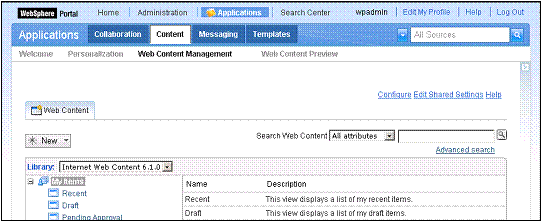
- Change the library from default Internet Web Content 6.1.0 to Intranet
Web Content 6.1.0. Go to the Content to verify that you have an
Intranet site with a Home – Announcements site area.
Notice the Announcement List that controls the list view, and two
announcement entries Employee Achievements and Company
Milestones. For example:

- Go to the Home level; select Announcements; then, click Edit.
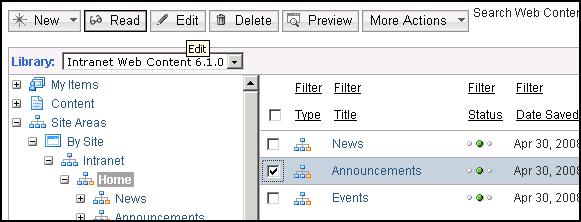
- On the Announcements tab, Manage Elements

- In the Element type list, select Short Text. In
the Name field, type PageURLMapping. In the Display title field, type Page URL Mapping. Click
Add; then, click OK.
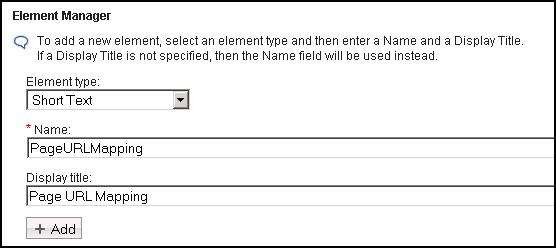
- In the Page URL Mapping field, type intranet. This
portal page is where the announcements are shown. Click Save and Close. We can repeat this step for other site areas, News, and
Events.

- Use Mozilla Firefox, open...
- To add rich text to your feeds, put text into CDATA tags, <![Data[, and
]]>. Add the text in text components; then add the text components to the menu
component.
- Create a text component, click New > Component > Text.
- Complete the fields:
Name Type CData Start. Display title Type CData Start. Text Element Type <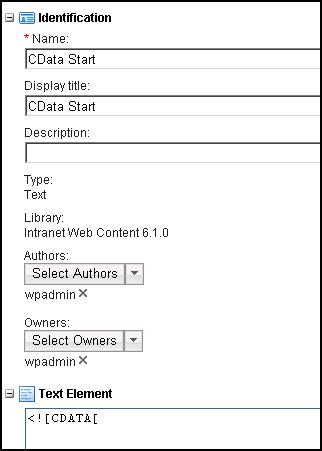
- Add access to all users (including anonymous). Expand the Access section.
In the Contributor User Defined list, select [all
users].
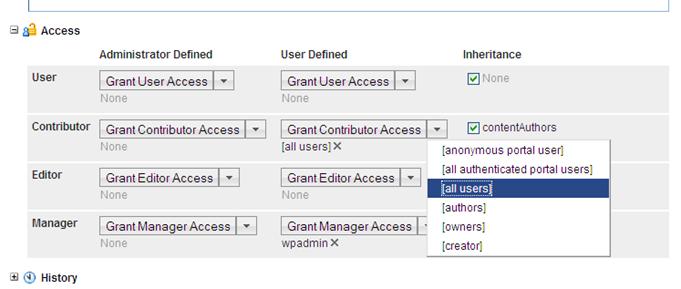
- Click Save to save the text component.
- Click Save as to create another text component that is based on the one
you created. Name this component CData End. In the Text Element
field, type ]]>. For example:
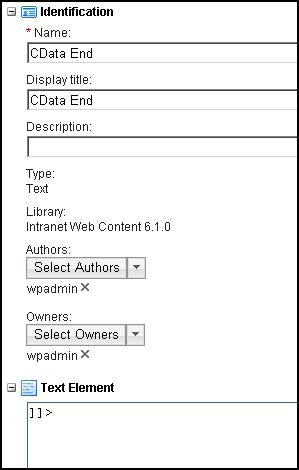
- Click Save and Close.
- Create a menu component.
- Click New > Component > Menu
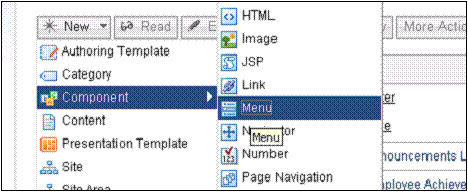
- In the Identification page, set the following options:
- Site Areas
- Exclude current content from results
- Current content
- Merge selected site areas with included site areas
Identification section Name Atom Feed Menu Display title Atom Feed Menu Description Menu that creates an Atom feed for an existing site area Menu element query Further options For example:
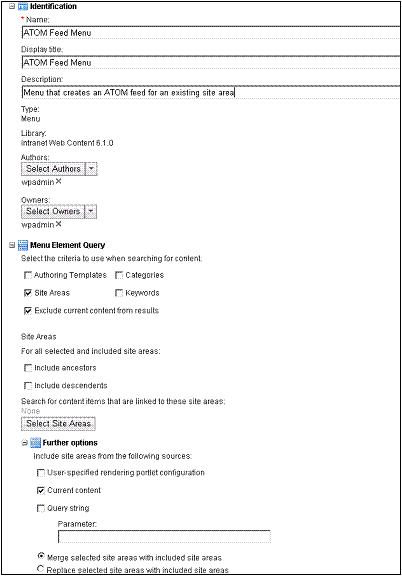
- Add the following code in the header.
<?xml version="1.0" encoding="utf-8" standalone="yes"?> <feed xmlns="http://www.w3.org/2005/Atom" > <title><IDCmpnt context="current" type="content" field="title"/></title> <link href="<PathCmpnt type="base"/> <URLCmpnt context="current" type="content" mode="standalone"/>"> </link> <updated><HistoryCmpnt context="current" type="content" field="lastmodifieddate" format="yyyy-dd-MM'T'hh:mm:ss'Z'"/></updated> <author> <name><IDCmpnt context="current" type="content" field="authors" format="cn"/></name> </author> <id> <PathCmpnt type="base"/><URLCmpnt context="current" type="content" mode="standalone"/> </id> <generator uri="your_Web_Content_Management_site">Web Content Management</generator>
Where your_Web_Content_Management_site is the URI value for your IBM Web Content Manager site. Based on the current context, the default content for a site area, it creates this example code:
<?xml version="1.0" encoding="utf-8" standalone="yes"?> <feed xmlns="http://www.w3.org/2005/Atom"> <title>Announcements List</title> <link rel="self" href="http://portal.ibm.com:10040/wps/myportal/intranet?WCM_GLOBAL_CONTEXT= /wps/wcm/myconnect/Intranet+Web+Content+6.1.0/IntranetSite/Home/Announcements/AnnouncementsList"> </link> <updated>2008-06-24T12:24:57Z</updated> <author> <name>uid=xyzadmin,o=defaultWIMFileBasedRealm</name> </author> <id>http://portal.ibm.com:10040/wps/myportal/intranet?WCM_GLOBAL_CONTEXT= /wps/wcm/connect/Intranet+Web+Content+6.1.0/IntranetSite/Home/Announcements/AnnouncementsList </id> <generator uri="your_Web_Content_Management_site">Web Content Management</generator>
Note: This code is separated across multiple lines for readability.
Where your_Web_Content_Management_site is the URI value for your IBM Web Content Manager site.
- Enter the following code in Design for each menu search result:
<entry> <title type="text"><IDCmpnt context="autoFill" type="content" field="title"/></title> <link rel="alternate" type="text/html" href="<PathCmpnt type="base"/><URLCmpnt context="autoFill" type="content" mode="standalone"/>"> </link> <id><IDCmpnt context="autoFill" type="content" field="id" format="id"/></id> <published><WorkflowCmpnt context="autoFill" type="content" field="publishdate" format="yyyy-dd-MM'T'hh:mm:ss'Z'"/></published> <updated><HistoryCmpnt context="autoFill" type="content" field="lastmodifieddate" format="yyyy-dd-MM'T'hh:mm:ss'Z'"/></updated> <summary><Element context="autoFill" type="content" key="Summary"/></summary> <content type="image/jpeg" src='<PathCmpnt type="base"/><Element context="autoFill" type="content" key="Image" format="url" htmlencode="true"/>'></content> <category term="<ProfileCmpnt context="autoFill" type="content" field="categories"/>" ></category> <author> <name> <IDCmpnt context="current" type="content" field="authors" format="cn"/> </name> </author> </entry> - Enter the footer in the code to end the feed:</feed>
For example:
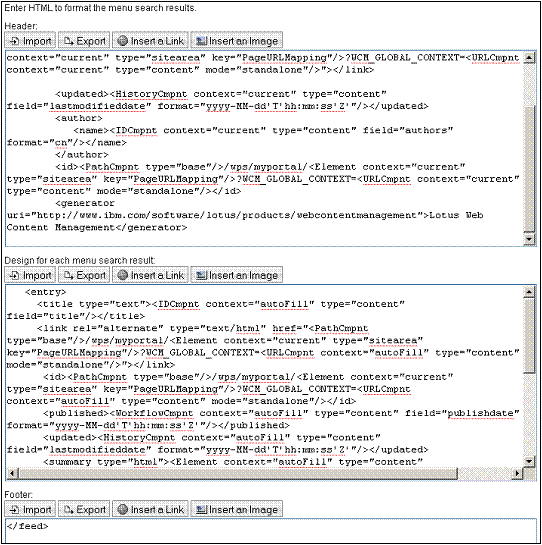
- Click Save. Notice that an ID is added to the component tags.
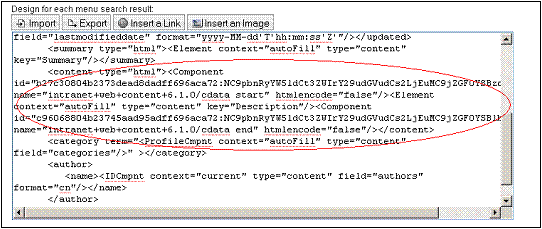 If this ID is not added, verify that the correct names were used for the components.
If this ID is not added, verify that the correct names were used for the components.
- Allow this menu to be read by all users (including anonymous users). Expand the Access section
and add [all users] to User-Defined users.
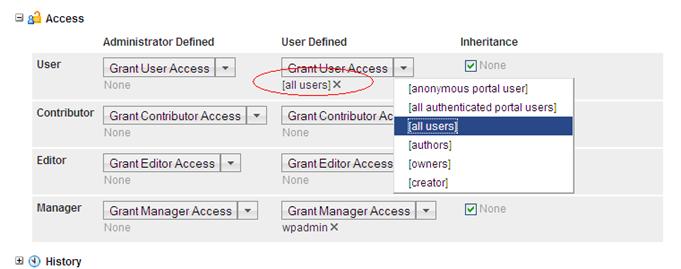
- Click New > Component > Menu
- Test your Atom Feed Menu.
- Click Preview.

- Select...
-
Intranet Web Content 6.1.0 library | Intranet | Home | Announcements | Announcements List

- Click Preview.
- Creating sample data for feeds to output.
- Select an authoring template.
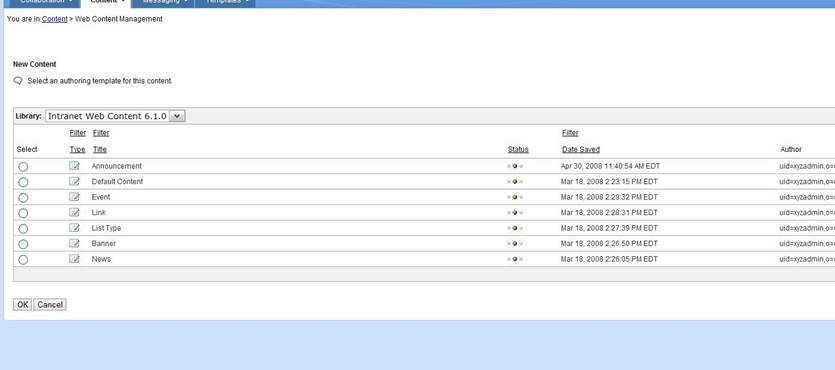

- Choose the option to create new content.
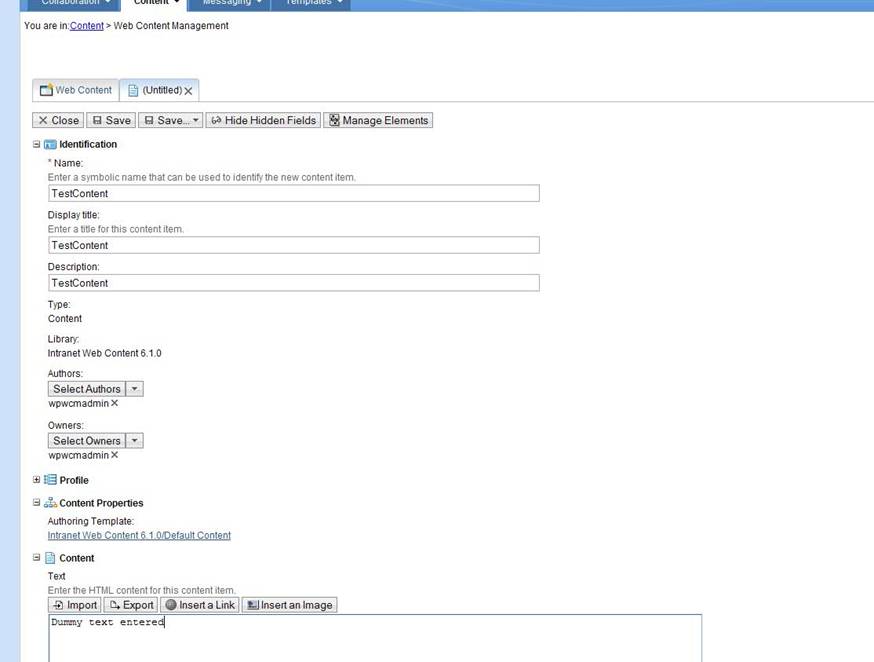
- Click Manage Elements and add the attribute type.


- Click OK.
- Select a URL for the image.
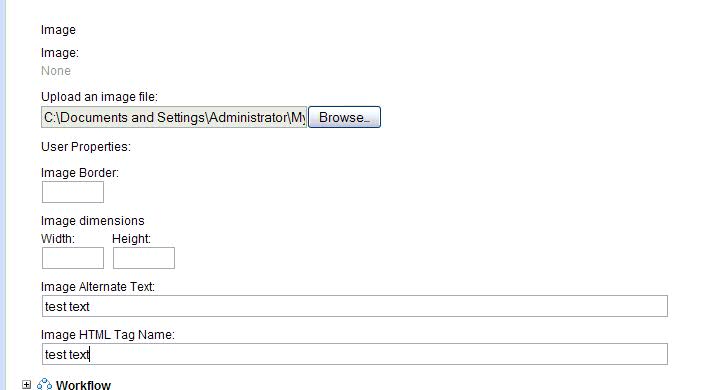
- Click Save.
- When prompted to pick a category, browse to one and pick a site. For example, maybe, announcements.
- Select an authoring template.
- Overview of the web feed utility
A web feed is an XML file that is specially coded to list the latest updates in a machine-readable format. The web feed utility offers a new solution to work with these updates and their static, unstructured content. - Configure the web feed utility
To configure the web feed utility, configure the Data Load utility, and create a configuration file that conforms to the Web-Feed-config.xsd schema. - webFeedLoad utility
The webFeedLoad utility facilitates the integration of a web feed with WebSphere Commerce. - webFeedLoad best practices
When running the webFeedLoad utility follow these best practices. - Task flow: Using the web feed utility
In this example, you explore the content management integration feature by uploading an image file published through Atom feed. - Customizing web feed integration
We can customize web feed integration with WebSphere Commerce in the following ways: write a custom feed parser to read feeds in an unsupported format; write a business object mediator to load data into specific tables, write an implementation to handle content management system-specific security.
Related concepts
Overview of the web feed utility